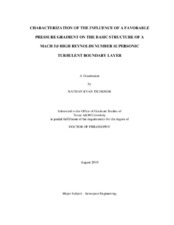| dc.description.abstract | High-speed high Reynolds number boundary layer flows with mechanical non-equilibrium effects have numerous practical applications; examples include access-to-space ascent, re-entry and descent, and military hypersonic systems. However, many of the basic turbulent flow processes in this regime are poorly understood and are beyond the realm of modern direct numerical simulations Previous studies have shown that curvature driven pressure gradients significantly alter the state of the turbulence in high-speed boundary layers; the turbulence levels have been shown to decrease by large amounts (up to 100 percent) and the Reynolds shear stress has been shown to change sign. However, most of our understanding is based on point measurement techniques such as hot-wire and Laser Doppler anemometry acquired at low to moderate supersonic Mach numbers (i.e., M = 2-3). After reviewing the available literature, the following scientific questions remain unanswered pertaining to the effect of favorable pressure gradients:
(1) How is state of the mean flow and turbulence statistics altered?
(2) How is the structure of wall turbulence; break-up, stretch or a combination?
(3) How are the Reynolds stress component production mechanisms altered?
(4) What is the effect of Mach number on the above processes?
To answer these questions and to enhance the current database, an experimental analysis was performed to provide high fidelity documentation of the mean and turbulent flow properties using two-dimensional particle image velocimetry (PIV) along with flow visualizations of a high speed (M4.88=), high Reynolds number (Re36,000θ≈) supersonic turbulent boundary layer with curvature-driven favorable pressure gradients (a nominally zero, a weak, and a strong favorable pressure gradient). From these data, detailed turbulence analyses were performed including calculating classical mean flow and turbulence statistics, examining turbulent stress production, and performing quadrant decomposition of the Reynolds stress for each pressure gradient case.
It was shown that the effect of curvature-driven favorable pressure gradients on the turbulent structure of a supersonic boundary layer was significant. For the strong pressure gradient model, the turbulent shear stress changed sign throughout the entire boundary layer; a phenomena was not observed to this magnitude in previous studies. Additionally, significant changes were seen in the turbulent structure of the boundary layer. It is believed that hairpin vortices organized within the boundary layer are stretched and then broken up over the favorable pressure gradient. Energy from these hairpin structures is transferred to smaller turbulent eddies as well as back into the mean flow creating a fuller mean velocity profile. It was determined that the effects of favorable pressure gradients on the basic structure of a turbulent Mach 5.0 boundary layer were significant, therefore increasing the complexity of computational modeling. | en |


